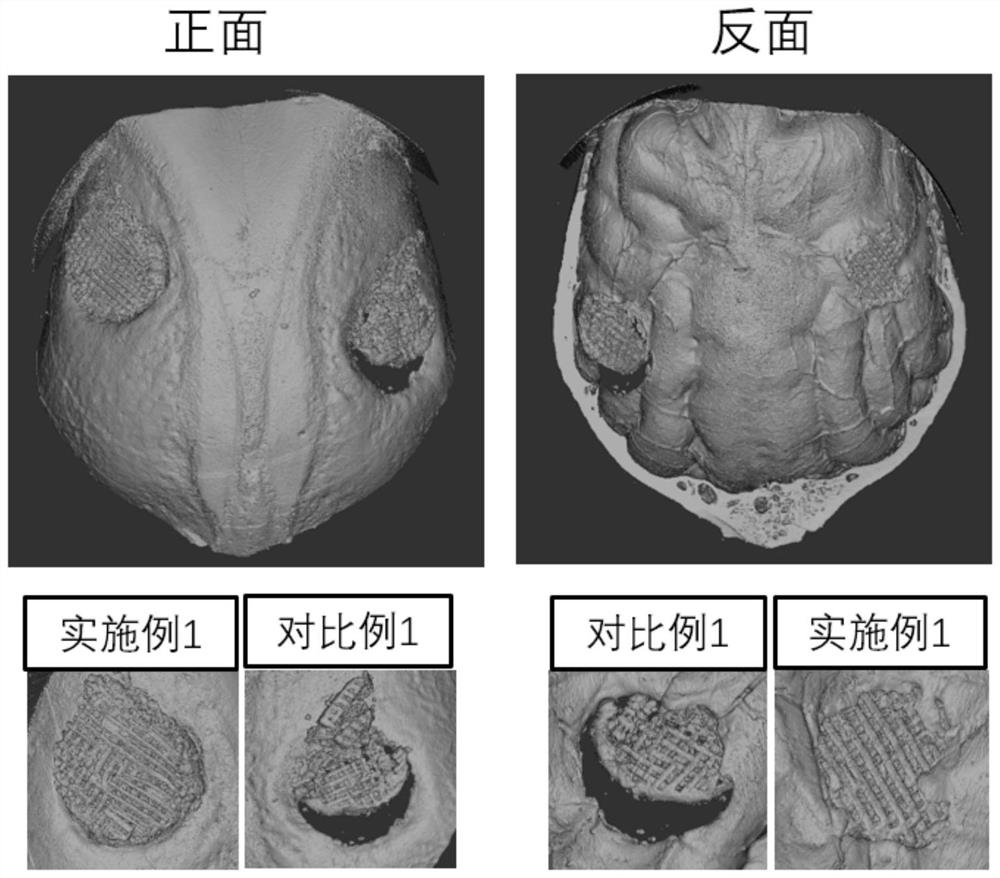3D printing bone tissue engineering stent with slow release and osteogenesis promoting functions and preparation method and application of 3D printing bone tissue engineering stent
A tissue engineering scaffold and 3D printing technology, applied in the field of biomedical materials, can solve the problems of slow healing of bone tissue and poor osteogenic performance
- Summary
- Abstract
- Description
- Claims
- Application Information
AI Technical Summary
Problems solved by technology
Method used
Image
Examples
Embodiment 1
[0047] (1) Preparation of 3D printing ink
[0048] In a water bath at 30°C, add sodium alginate powder material to deionized water to prepare a 6% sodium alginate solution, add 1ml of icariin-dimethyl sulfoxide solution with a concentration of 0.1g / ml, and use a magnetic Mix it well with a mixer until smooth. After preheating at 50°C for 30-60 minutes, reduce the viscosity of the sodium alginate solution, then slowly add the solid calcium phosphate powder into the preheated solution, and mix the slurry evenly with a homogeneous mixer until no phosphoric acid is observed Calcium agglomerates. The mass ratio of calcium phosphate, sodium alginate, icariin and deionized water in the final slurry is 25:6:0.08:100. This mixed slurry is used as 3D printing ink.
[0049] (2) printing support
[0050] The three-dimensional model of the scaffold was designed by 3D modeling software, and the mixed ink was printed into a calcium phosphate scaffold with a first-level macroporous structur...
Embodiment 2
[0062] The 3D printed bone tissue engineering scaffold material was prepared with reference to the method described in Example 1, which differs from Example 1 in that the mass ratio of calcium phosphate, sodium alginate, icariin and deionized water was adjusted to 25:6 : 0.04: 100, all the other processing methods are the same as those described in Example 1. The experimental results show that the obtained scaffold has a slow-release function and an osteogenesis-promoting effect, but compared with Example 1, due to the lower solid content of icariin in the printing paste, bone tissue with slow-release and osteogenesis-promoting functions The total drug loading of the engineering scaffold is less, and the osteogenesis-promoting function of the scaffold obtained in this embodiment on bone defects is better than that of Comparative Example 1, but slightly worse than that of Example 1.
Embodiment 3
[0064] The 3D printed bone tissue engineering scaffold material was prepared with reference to the method described in Example 1, which differs from Example 1 in that the mass ratio of calcium phosphate, sodium alginate, icariin and deionized water was adjusted to 25:6 : 0.16: 100, all the other processing methods are the same as those described in Example 1. The experimental results show that the obtained scaffold has slow-release function and osteogenesis-promoting effect. Since the solid content of icariin in the printing slurry is more than that of Examples 1 and 2, the bone tissue engineering scaffold with slow-release and osteogenesis-promoting function The total amount of drug loaded is more, and the bone defect-promoting function of the scaffold obtained in this embodiment is better than that of Examples 1 and 2.
PUM
| Property | Measurement | Unit |
|---|---|---|
| concentration | aaaaa | aaaaa |
Abstract
Description
Claims
Application Information
 Login to View More
Login to View More - R&D
- Intellectual Property
- Life Sciences
- Materials
- Tech Scout
- Unparalleled Data Quality
- Higher Quality Content
- 60% Fewer Hallucinations
Browse by: Latest US Patents, China's latest patents, Technical Efficacy Thesaurus, Application Domain, Technology Topic, Popular Technical Reports.
© 2025 PatSnap. All rights reserved.Legal|Privacy policy|Modern Slavery Act Transparency Statement|Sitemap|About US| Contact US: help@patsnap.com


